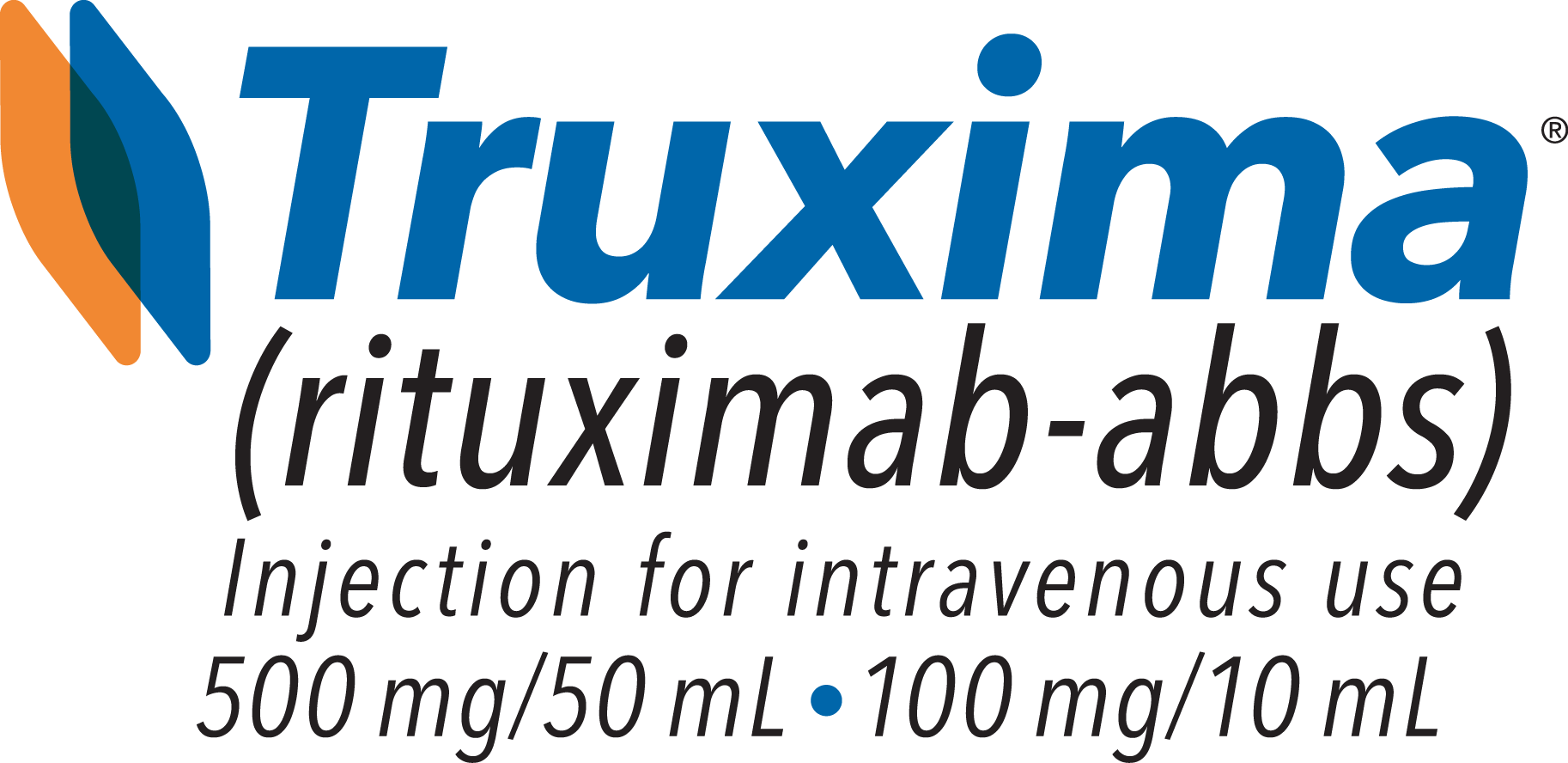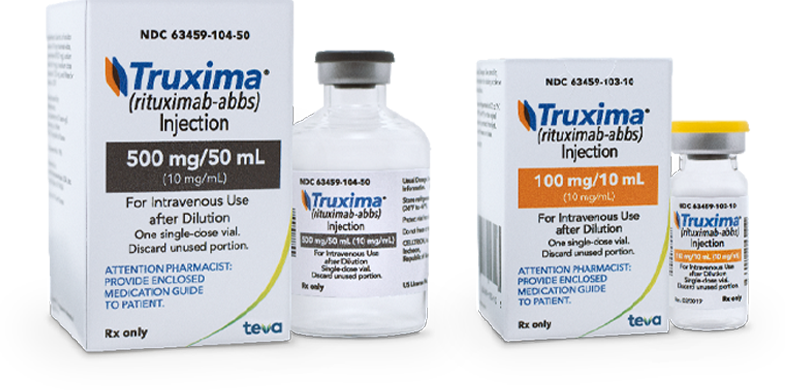IMPORTANT SAFETY INFORMATION
WARNING: FATAL INFUSION-RELATED REACTIONS, SEVERE MUCOCUTANEOUS REACTIONS, HEPATITIS B VIRUS REACTIVATION and PROGRESSIVE MULTIFOCAL LEUKOENCEPHALOPATHY
Infusion-Related Reactions: Administration of rituximab products can result in serious, including fatal, infusion-related reactions. Deaths within 24 hours of rituximab infusion have occurred. Approximately 80% of fatal infusion-related reactions occurred in association with the first infusion. Monitor patients closely. Discontinue TRUXIMA infusion for severe reactions and provide medical treatment for Grade 3 or 4 infusion-related reactions.
Severe Mucocutaneous Reactions: Severe, including fatal, mucocutaneous reactions can occur in patients receiving rituximab products.
Hepatitis B Virus (HBV) Reactivation: HBV reactivation can occur in patients treated with rituximab products, in some cases resulting in fulminant hepatitis, hepatic failure, and death. Screen all patients for HBV infection before treatment initiation, and monitor patients during and after treatment with TRUXIMA. Discontinue TRUXIMA and concomitant medications in the event of HBV reactivation.
Progressive Multifocal Leukoencephalopathy (PML), including fatal PML, can occur in patients receiving rituximab products.
WARNINGS AND PRECAUTIONS
Infusion-Related Reactions - Rituximab products can cause severe, including fatal, infusion-related reactions. Severe reactions typically occurred during the first infusion with time to onset of 30-120 minutes. Rituximab product-induced infusion-related reactions and sequelae include urticaria, hypotension, angioedema, hypoxia, bronchospasm, pulmonary infiltrates, acute respiratory distress syndrome, myocardial infarction, ventricular fibrillation, cardiogenic shock, anaphylactoid events, or death.
Premedicate patients with an antihistamine and acetaminophen prior to dosing. For RA, GPA and MPA, and PV patients, methylprednisolone 100 mg intravenously or its equivalent is recommended 30 minutes prior to each infusion. Institute medical management (e.g. glucocorticoids, epinephrine, bronchodilators, or oxygen) for infusion-related reactions as needed. Depending on the severity of the infusion-related reaction and the required interventions, temporarily or permanently discontinue TRUXIMA. Resume infusion at a minimum 50% reduction in rate after symptoms have resolved. Closely monitor the following patients: those with pre-existing cardiac or pulmonary conditions, those who experienced prior cardiopulmonary adverse reactions, and those with high numbers of circulating malignant cells (greater than or equal to 25,000/mm3).
Severe Mucocutaneous Reactions - Mucocutaneous reactions, some with fatal outcome, can occur in patients treated with rituximab products. These reactions include paraneoplastic pemphigus, Stevens-Johnson syndrome, lichenoid dermatitis, vesiculobullous dermatitis, and toxic epidermal necrolysis. The onset of these reactions has been variable and includes reports with onset on the first day of rituximab exposure. Discontinue TRUXIMA in patients who experience a severe mucocutaneous reaction. The safety of re-administration of rituximab products to patients with severe mucocutaneous reactions has not been determined
Hepatitis B Virus Reactivation - Hepatitis B virus (HBV) reactivation, in some cases resulting in fulminant hepatitis, hepatic failure and death, can occur in patients treated with drugs classified as CD20-directed cytolytic antibodies, including rituximab products. Cases have been reported in patients who are hepatitis B surface antigen (HBsAg) positive and also in patients who are HBsAg negative but are hepatitis B core antibody (anti-HBc) positive. Reactivation has also occurred in patients who appear to have resolved hepatitis B infection (i.e., HBsAg negative, anti-HBc positive and hepatitis B surface antibody [anti-HBs] positive).
HBV reactivation is defined as an abrupt increase in HBV replication manifesting as a rapid increase in serum HBV DNA levels or detection of HBsAg in a person who was previously HBsAg negative and anti-HBc positive. Reactivation of HBV replication is often followed by hepatitis, i.e., increase in transaminase levels. In severe cases, increase in bilirubin levels, liver failure, and death can occur.
Screen all patients for HBV infection by measuring HBsAg and anti-HBc before initiating treatment with TRUXIMA. For patients who show evidence of prior hepatitis B infection (HBsAg positive [regardless of antibody status] or HBsAg negative but anti-HBc positive), consult with physicians with expertise in managing hepatitis B regarding monitoring and consideration for HBV antiviral therapy before and/or during TRUXIMA treatment.
Monitor patients with evidence of current or prior HBV infection for clinical and laboratory signs of hepatitis or HBV reactivation during and for several months following TRUXIMA therapy. HBV reactivation has been reported up to 24 months following completion of rituximab therapy.
In patients who develop reactivation of HBV while on TRUXIMA, immediately discontinue TRUXIMA and any concomitant chemotherapy, and institute appropriate treatment. Insufficient data exist regarding the safety of resuming TRUXIMA treatment in patients who develop HBV reactivation. Resumption of TRUXIMA treatment in patients whose HBV reactivation resolves should be discussed with physicians with expertise in managing HBV.
Progressive Multifocal Leukoencephalopathy (PML) - JC virus infection resulting in PML and death can occur in rituximab product-treated patients with hematologic malignancies or with autoimmune diseases. The majority of patients with hematologic malignancies diagnosed with PML received rituximab in combination with chemotherapy or as part of a hematopoietic stem cell transplant. The patients with autoimmune diseases had prior or concurrent immunosuppressive therapy. Most cases of PML were diagnosed within 12 months of their last infusion of rituximab.
Consider the diagnosis of PML in any patient presenting with new-onset neurologic manifestations. Evaluation of PML includes, but is not limited to, consultation with a neurologist, brain MRI, and lumbar puncture.
Discontinue TRUXIMA and consider discontinuation or reduction of any concomitant chemotherapy or immunosuppressive therapy in patients who develop PML.
Tumor Lysis Syndrome (TLS) - Acute renal failure, hyperkalemia, hypocalcemia, hyperuricemia, or hyperphosphatemia from tumor lysis, sometimes fatal, can occur within 12 to 24 hours after the first infusion of rituximab products in patients with NHL. A high number of circulating malignant cells (≥25,000/mm3) or high tumor burden, confers a greater risk of TLS.
Administer aggressive intravenous hydration and anti-hyperuricemic therapy in patients at high risk for TLS. Correct electrolyte abnormalities, monitor renal function and fluid balance, and administer supportive care, including dialysis as indicated.
Infections - Serious, including fatal, bacterial, fungal, and new or reactivated viral infections can occur during and following the completion of rituximab product-based therapy. Infections have been reported in some patients with prolonged hypogammaglobulinemia (defined as hypogammaglobulinemia >11 months after rituximab exposure). New or reactivated viral infections included cytomegalovirus, herpes simplex virus, parvovirus B19, varicella zoster virus, West Nile virus, and hepatitis B and C. Discontinue TRUXIMA for serious infections and institute appropriate anti-infective therapy. TRUXIMA is not recommended for use in patients with severe, active infections.
Cardiovascular Adverse Reactions - Cardiac adverse reactions, including ventricular fibrillation, myocardial infarction, and cardiogenic shock may occur in patients receiving rituximab products. Discontinue infusions for serious or life-threatening cardiac arrhythmias. Perform cardiac monitoring during and after all infusions of TRUXIMA for patients who develop clinically significant arrhythmias, or who have a history of arrhythmia or angina.
Renal Toxicity - Severe, including fatal, renal toxicity can occur after rituximab product administration in patients with NHL. Renal toxicity has occurred in patients who experience TLS and in patients with NHL administered concomitant cisplatin therapy during clinical trials. The combination of cisplatin and TRUXIMA is not an approved treatment regimen. Monitor closely for signs of renal failure and discontinue TRUXIMA in patients with a rising serum creatinine or oliguria.
Bowel Obstruction and Perforation - Abdominal pain, bowel obstruction and perforation, in some cases leading to death, can occur in patients receiving rituximab products in combination with chemotherapy. In postmarketing reports, the mean time to documented gastrointestinal perforation was 6 (range 1 to 77) days in patients with NHL. Evaluate if symptoms of obstruction such as abdominal pain or repeated vomiting occur.
Immunization - The safety of immunization with live viral vaccines following rituximab product therapy has not been studied and vaccination with live virus vaccines is not recommended before or during treatment.
Prior to initiating TRUXIMA physicians should ensure patients’ vaccinations and immunizations are up-to-date with guidelines. Administration of any non-live vaccines should occur at least 4 weeks prior to a course of TRUXIMA.
Embryo-Fetal Toxicity - Based on human data, rituximab products can cause fetal harm due to B-cell lymphocytopenia in infants exposed in-utero. Advise pregnant women of the potential risk to a fetus. Advise females of reproductive potential to use effective contraception during treatment with TRUXIMA and for 12 months after the last dose. Verify pregnancy status in females with reproductive potential before starting TRUXIMA.
Concomitant Use With Other Biologic Agents and Disease Modifying Antirheumatic Drugs (DMARDs), Other Than Methotrexate, in RA, GPA, and MPA, PV
Limited data are available on the safety of the use of biologic agents or DMARDs other than methotrexate in RA patients exhibiting peripheral B-cell depletion following treatment with rituximab products. Observe patients closely for signs of infection if biologic agents and/or DMARDs are used concomitantly.
Use of concomitant immunosuppressants other than corticosteroids has not been studied in GPA or MPA or PV patients exhibiting peripheral B-cell depletion following treatment with rituximab products.
Use in RA Patients Who Have Not Had Prior Inadequate Response to Tumor Necrosis Factor (TNF) Antagonists
The use of TRUXIMA in patients with RA who have not had prior inadequate response to one or more TNF antagonists is not recommended.
Lactation - There are limited data on the presence of rituximab in human milk and the effect on the breastfed child, and there are no data on the effect on milk production. Rituximab has been reported to be excreted at low concentrations in human breast milk. Given that the clinical significance of this finding for children is not known, advise women not to breastfeed during treatment with TRUXIMA and for 6 months after the last dose due to the potential of serious adverse reactions in breastfed children.
Most common adverse reactions in clinical trials of NHL (≥25%) were: infusion-related reactions, fever, lymphopenia, chills, infection, and asthenia.
Most common adverse reactions in clinical trials of CLL (≥25%) were: infusion-related reactions and neutropenia.
Most common adverse reactions in clinical trials of RA (≥10%) were: upper respiratory tract infection, nasopharyngitis, urinary tract infection, and bronchitis (other important adverse reactions include infusion-related reactions, serious infections, and cardiovascular events).
Most common adverse reactions in clinical trials of GPA and MPA (≥15%) were: infections, nausea, diarrhea, headache, muscle spasms, anemia, peripheral edema, and infusion-related reactions.
Most common adverse reactions in clinical trials of PV (greater than or equal to 15%) were: were: infusion-related reactions, depression, upper respiratory tract infection/nasopharyngitis, headache (other important adverse reactions include infections).



